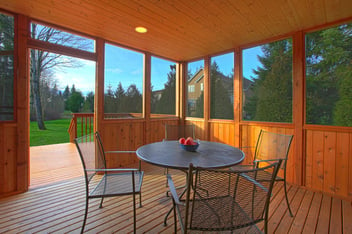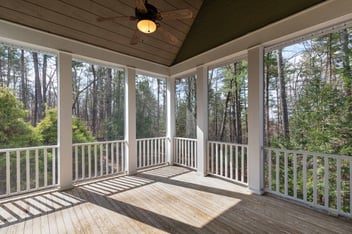3 Min Read
The Ultimate Guide to Home Addition Costs & ROI in Apex, Wake County
For many Wake County families, the big question isn’t “Do we need more space?” — it’s “Should we move or invest in a home addition?” With housing inventory still tight and mortgage rates higher than years past, more homeowners in Apex, Cary, and Holly Springs are deciding to stay put and expand instead.
But before you break ground, it’s critical to understand what impacts the cost of a home addition and how these investments translate into return on investment (ROI) — both financially and in quality of life.
At Triple Crown Contractors, we specialize in designing and building smarter, cleaner, and more personal home additions that fit your lifestyle and your budget. In this guide, we’ll break down the main cost drivers, show you average ROI figures for our area, and help you plan with confidence.
What Impacts the Cost of a Home Addition?
No two home additions are alike — but several key factors drive costs across projects in Wake County.
1. Size & Scope of the Addition
- Smaller bump-outs (100–200 sq. ft.) for breakfast nooks or mudrooms often start at lower price points.
- Full suites (primary bedroom + bathroom, 400–600 sq. ft.) can significantly increase costs.
- Two-story additions generally cost more per square foot due to added engineering and roofing needs.
2. Type of Addition
- Primary Suite Addition: Higher due to bathroom plumbing, high-end finishes, and HVAC load increases.
- ADU (Accessory Dwelling Unit): Adds complexity with kitchens, baths, and often separate entrances.
- Sunrooms/Porches: Typically less expensive per square foot but still influenced by insulation, HVAC tie-ins, and window systems.
3. Design & Engineering Requirements
Wake County and its municipalities (Cary, Apex, Holly Springs) often have setback, height, and zoning restrictions that impact design. Engineering for structural tie-ins, foundation depth, and load bearing also adds cost.
4. Materials & Finishes
The price of lumber, concrete, windows, and roofing has stabilized since pandemic highs — but still sits above pre-2020 levels. Finishes (tile, cabinetry, flooring) can also swing the budget significantly.
5. Labor & Permitting
With demand high and skilled trades in short supply, labor remains one of the largest cost factors. Cary recently updated its ADU permit rules to streamline approvals, but fees and inspections still play into the budget.
Typical Cost Ranges for Home Additions in Wake County
(These ranges are approximate and based on 2025 local market averages. Your exact pricing will vary depending on scope, design, and finishes.)
- Small Bump-Outs (100–200 sq. ft.): $60,000 – $100,000
- Primary Suite Additions (400–600 sq. ft.): $140,000 – $200,000+
- Two-Story Additions (600–1,200 sq. ft.): $200,000 – $400,000+
- Sunrooms / Four-Season Rooms (150–300 sq. ft.): $60,000 – $120,000
- Accessory Dwelling Units (ADUs, 400–800 sq. ft.): $150,000 – $300,000+
What’s the ROI on a Home Addition?
When considering return on investment, think in two dimensions:
1. Financial ROI (Resale Value)
According to remodeling industry data:
- Primary Suite Additions: Recoup ~60–70% at resale.
- Bathroom Additions: Recoup ~55–65%.
- Sunroom/Outdoor Rooms: Recoup ~50–60%.
- ADUs: Recoup ~65–80% (especially in markets with strong rental demand like Cary and Holly Springs).
2. Lifestyle ROI (Everyday Value)
- Avoiding the cost and stress of moving.
- Creating comfort for aging parents or multigenerational living.
- Expanding work-from-home flexibility.
- Reducing energy costs with efficient systems (smart HVAC, solar-ready designs).
Triple Crown clients often say their greatest ROI isn’t resale, but the immediate daily impact on how their family lives and grows in their home.
How Triple Crown Contractors Maximizes ROI
While competitors often focus only on square footage, we focus on value per square foot by integrating:
- Options for Energy Efficiency: Rebates + long-term savings through advanced HVAC, insulation, and solar-ready prep.
- Builder-Direct Communication: Faster decisions, fewer delays, and reduced overhead costs.
- Future-Proof Design: Layouts for aging-in-place, multi-gen living, and resale appeal.
- Local Expertise: Cary’s new ADU rules, Apex zoning, Holly Springs permitting — we navigate red tape for you.
This combination means your addition isn’t just more space — it’s a smarter investment.
FAQs About Home Addition Costs
Q: How long does a typical addition take in Wake County?
A: Most range from 3–6 months, depending on design, permitting, and weather.
Q: Can additions really save on energy bills?
A: Yes — when designed with energy efficiency in mind, your net utility costs may actually improve.
Q: Do additions always add resale value?
A: Well-executed additions in Wake County almost always boost resale appeal — especially primary suites, bathrooms, and ADUs.
Conclusion
A home addition is one of the biggest investments you can make — but when planned with clarity and executed with craftsmanship, it’s also one of the most rewarding.
At Triple Crown Contractors, we specialize in helping Wake County families expand smarter. From budgeting to design to construction, we deliver additions that maximize ROI in both dollars and daily living.



%20(1)-1.jpeg?width=352&name=IMG_2900%20(1)%20(1)-1.jpeg)
